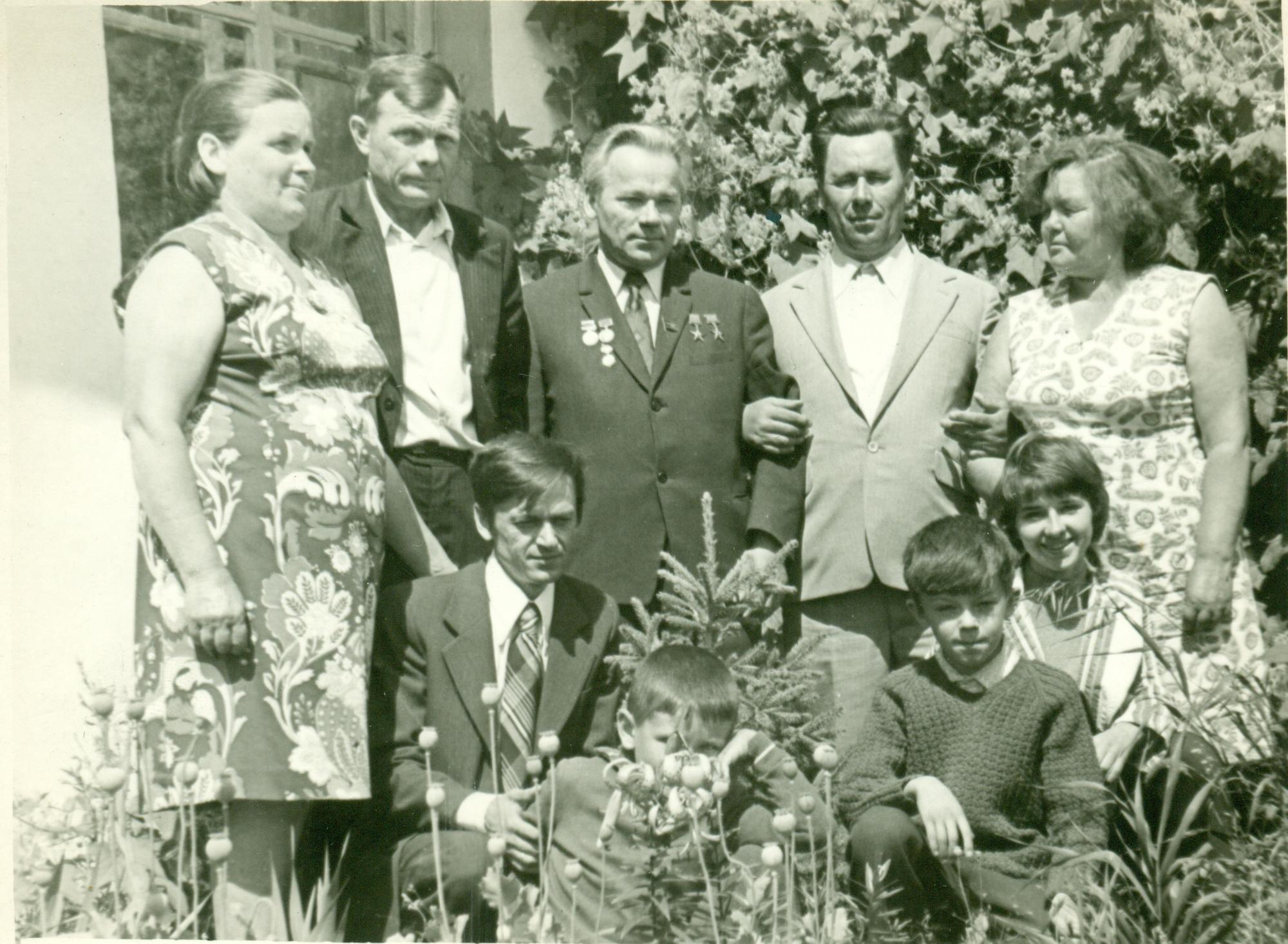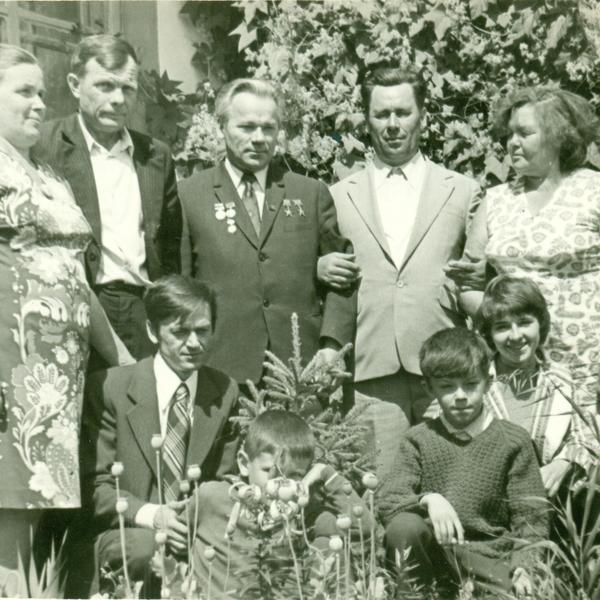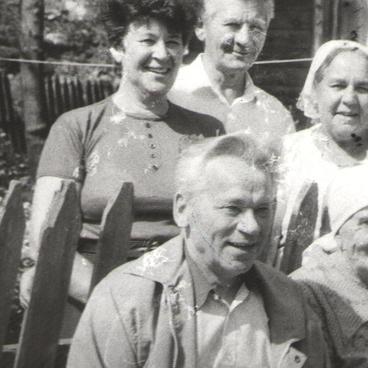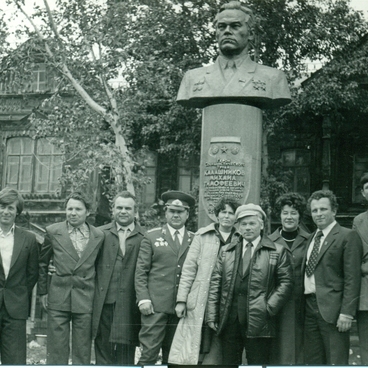In the photo, you can see Mikhail Timofeyevich Kalashnikov (center), his brother Vassily (second from the right), his son Victor and his daughter Natalia (left and right in the first line).
Mikhail Timofeyevich used every opportunity to come to his homeland, Altai. Each time he visited it, he not only met with his numerous relatives but also talked to local people: collective farm workers, schoolchildren, cultural workers and scientists. His most memorable visits to Altai took place in 1980, the year when his portrait sculpture was inaugurated in the village of Kurya, and in 2007, when he came to celebrate the 70th anniversary of the Altai Krai.
That is how Mikhail Kalashnikov himself talked about those places: ‘I’ve been to Altai as an adult many times, but each time I come I am surprised by the transformation that happens to me when I visit the land of my childhood. All the colors there are brighter, the spaces are wider, the sky is higher, the people are closer and more hospitable, and life itself captivates me with its mysteries and the sweet promise of new discoveries. That is how a child sees the world’.
Vassily is Mikhail’s younger brother. He went to war in 1943, was wounded and contused. After the victory, he returned to Altai, to Barnaul, where he worked and brought up his two sons. His marriage was not very happy, and at a certain moment, he left for Nizhni Tagil to live with his elder brother Victor, but could not stay far from his family and returned to Barnaul. He did not ever manage to find happiness in his love life and moved to his sisters to the country where he spent the last years of his life. He died at 75 years of age.
Victor Mikhailovich Kalashnikov (1942–2018) was Mikhail Timofeyevich’s elder son. He followed his father’s trade and became engineer of light weapons, Doctor of Science and Honored Engineer of Russian Federation. He is the author of 30 inventions (personally and in collaboration with other engineer), among which, the AL-7 machine gun (light machine gun, model 7), PP 19 Bizon (machine pistol, model 19) PP-19-01 Vityaz (a modified version of PP-19 Bizon). His family consists of his wife Luybov and his two sons: Alexander, head of automated control system department at the Spetsgazavtoprom plant, and Mikhail, a manager at the Izhevsk mechanical engineering plant. They also have their children: Alexander has a daughter named Alexandra, and Mikhail, a son named Daniil.
Natalia Mikhailovna Kalashnikova (1953–1983) was Mikhail Kalashnikov’s younger daughter.
She graduated from the Perm choreography college and the Izhevsk Mechanical Institute. She danced in the Udmurt dance band Zangari and later, worked in the patent department of the Izhevsk mechanical engineering plant. She died in a car accident.
Mikhail Timofeyevich used every opportunity to come to his homeland, Altai. Each time he visited it, he not only met with his numerous relatives but also talked to local people: collective farm workers, schoolchildren, cultural workers and scientists. His most memorable visits to Altai took place in 1980, the year when his portrait sculpture was inaugurated in the village of Kurya, and in 2007, when he came to celebrate the 70th anniversary of the Altai Krai.
That is how Mikhail Kalashnikov himself talked about those places: ‘I’ve been to Altai as an adult many times, but each time I come I am surprised by the transformation that happens to me when I visit the land of my childhood. All the colors there are brighter, the spaces are wider, the sky is higher, the people are closer and more hospitable, and life itself captivates me with its mysteries and the sweet promise of new discoveries. That is how a child sees the world’.
Vassily is Mikhail’s younger brother. He went to war in 1943, was wounded and contused. After the victory, he returned to Altai, to Barnaul, where he worked and brought up his two sons. His marriage was not very happy, and at a certain moment, he left for Nizhni Tagil to live with his elder brother Victor, but could not stay far from his family and returned to Barnaul. He did not ever manage to find happiness in his love life and moved to his sisters to the country where he spent the last years of his life. He died at 75 years of age.
Victor Mikhailovich Kalashnikov (1942–2018) was Mikhail Timofeyevich’s elder son. He followed his father’s trade and became engineer of light weapons, Doctor of Science and Honored Engineer of Russian Federation. He is the author of 30 inventions (personally and in collaboration with other engineer), among which, the AL-7 machine gun (light machine gun, model 7), PP 19 Bizon (machine pistol, model 19) PP-19-01 Vityaz (a modified version of PP-19 Bizon). His family consists of his wife Luybov and his two sons: Alexander, head of automated control system department at the Spetsgazavtoprom plant, and Mikhail, a manager at the Izhevsk mechanical engineering plant. They also have their children: Alexander has a daughter named Alexandra, and Mikhail, a son named Daniil.
Natalia Mikhailovna Kalashnikova (1953–1983) was Mikhail Kalashnikov’s younger daughter.
She graduated from the Perm choreography college and the Izhevsk Mechanical Institute. She danced in the Udmurt dance band Zangari and later, worked in the patent department of the Izhevsk mechanical engineering plant. She died in a car accident.



